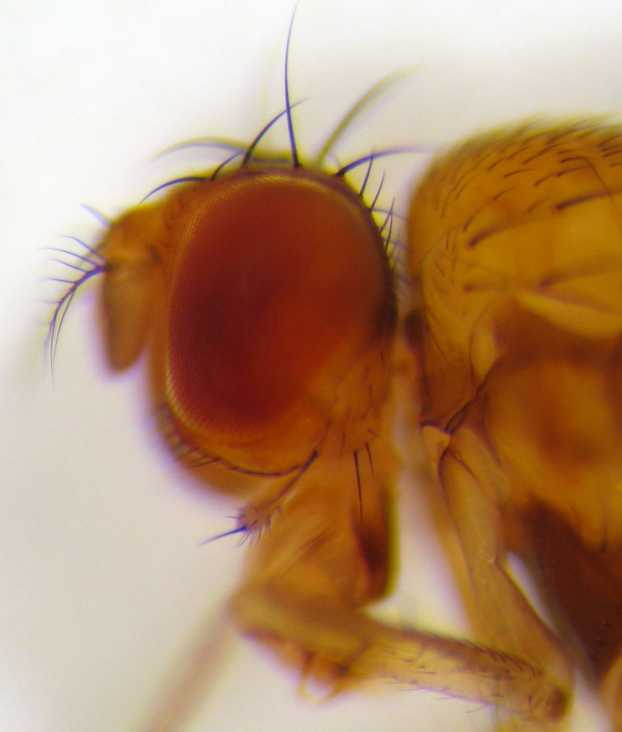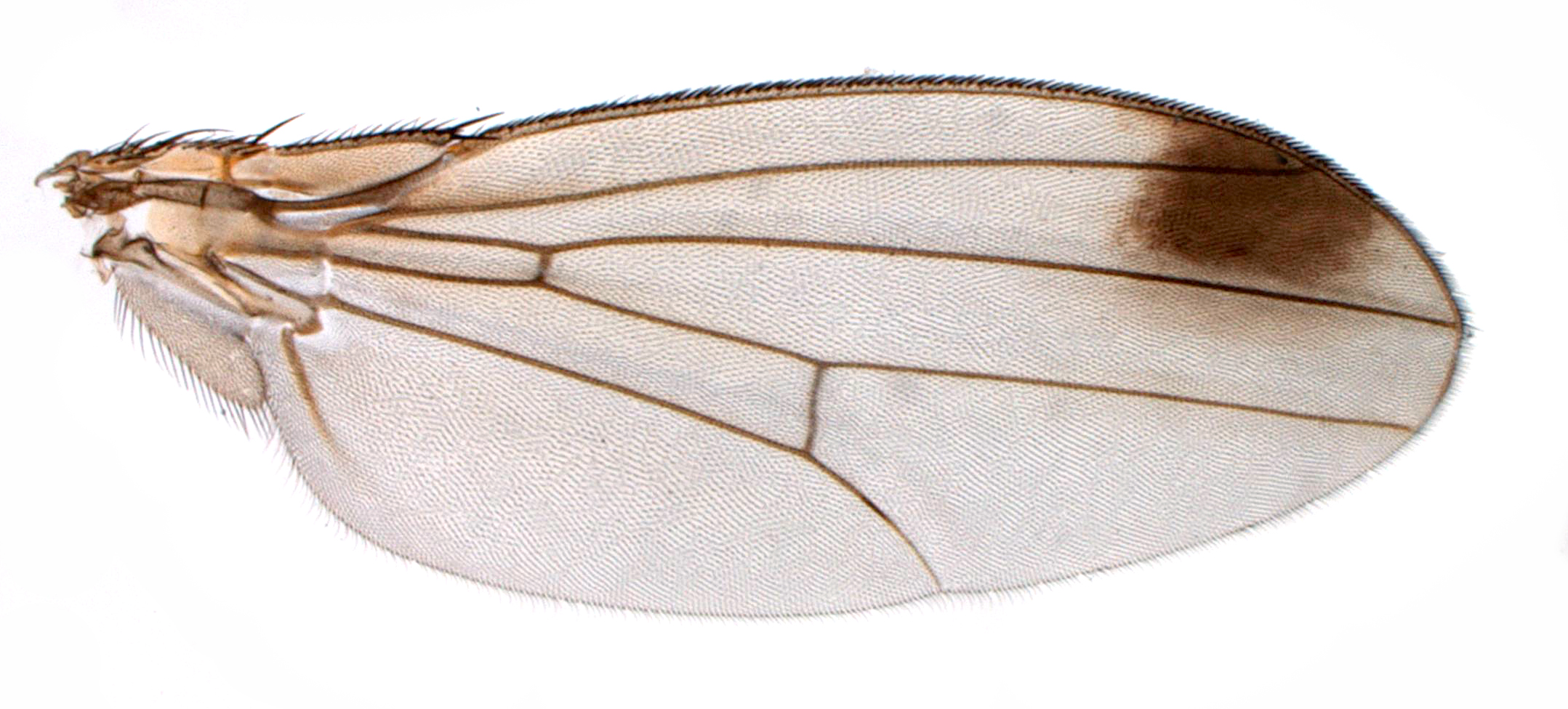|
Drosophilidae
The Drosophilidae are a diverse, cosmopolitan family of flies, which includes species called fruit flies, although they are more accurately referred to as vinegar or pomace flies. Another distantly related family of flies, Tephritidae, are true fruit flies because they are frugivorous, and include apple maggot flies and many pests. The best known species of the Drosophilidae is ''Drosophila melanogaster'', within the genus ''Drosophila'', also called the "fruit fly." ''Drosophila melanogaster'' is used extensively for studies concerning genetics, development, physiology, ecology and behaviour. Many fundamental biological mechanisms were discovered first in ''D. melanogaster.'' The fruit fly is mostly composed of post-mitotic cells, has a very short lifespan, and shows gradual aging. As in other species, temperature influences the life history of the animal. Several genes have been identified that can be manipulated to extend the lifespan of these insects. Additionally, ''Drosoph ... [...More Info...] [...Related Items...] OR: [Wikipedia] [Google] [Baidu] |
Scaptomyza Flava
''Scaptomyza flava'' is an herbivorous leaf mining fly species in the family Drosophilidae. In Latin, '' flava'' means golden or yellow. The fly is amber to dark brown in color and approximately 2.5 mm in length. In Europe and New Zealand the larvae are pests of plants in the order Brassicales, including arugula, brassicas, broccoli, Brussels sprouts, bok choy, cabbage, canola, cauliflower, horseradish, kale, kohlrabi, napa cabbage, nasturtium, radish, rapini, rutabaga, turnip, wasabi and watercress. In New Zealand, its range has expanded to include host species that are intercropped with salad brassicas, including gypsophila, otherwise known as baby's breath, which is in the pink family (Caryophyllaceae) and the pea (''Pisum sativum'') in the Fabaceae. More typically, ''S. flava'' is oligophagous within the Brassicales. ''Scaptomyza'' are unusual within the Drospophilidae because the group includes species that are truly herbivorous. Other herbivorous drosophilids include ' ... [...More Info...] [...Related Items...] OR: [Wikipedia] [Google] [Baidu] |
Drosophilinae
The Drosophilinae are the largest subfamily in the Drosophilidae. The other subfamily is the Steganinae. Phylogeny Many molecular studies have addressed small parts of the phylogenetic tree. Most of these studies are limited to species of the genus '' Drosophila''. The genus ''Drosophila'' is paraphyletic as several genera, such as ''Zaprionus'', ''Scaptomyza'' and ''Lordiphosa'', are positioned within the genus. Position of the bolded species in the phylogenetic tree is at least reasonably well supported by existing molecular evidence.Thomas, R. H. & J. A. Hunt 1993. Phylogenetic relationships in Drosophila: a conflict between molecular and morphological data. Molecular Biology and Evolution 10(2): 362-374.Yassin A, Araripe LO, Capy P, Da Lage J-L, Klaczko LB, Maisonhaute C, Ogereau D and David JR (2008) Grafting the molecular phylogenetic tree with morphological branches to reconstruct the evolutionary history of the genus Zaprionus (Diptera: Drosophilidae). Molec ... [...More Info...] [...Related Items...] OR: [Wikipedia] [Google] [Baidu] |
Drosophila
''Drosophila'' () is a genus of flies, belonging to the family Drosophilidae, whose members are often called "small fruit flies" or (less frequently) pomace flies, vinegar flies, or wine flies, a reference to the characteristic of many species to linger around overripe or rotting fruit. They should not be confused with the Tephritidae, a related family, which are also called fruit flies (sometimes referred to as "true fruit flies"); tephritids feed primarily on unripe or ripe fruit, with many species being regarded as destructive agricultural pests, especially the Mediterranean fruit fly. One species of ''Drosophila'' in particular, '' D. melanogaster'', has been heavily used in research in genetics and is a common model organism in developmental biology. The terms "fruit fly" and "''Drosophila''" are often used synonymously with ''D. melanogaster'' in modern biological literature. The entire genus, however, contains more than 1,500 species and is very diverse in appea ... [...More Info...] [...Related Items...] OR: [Wikipedia] [Google] [Baidu] |
Drosophila Suzukii
''Drosophila suzukii'', commonly called the spotted wing drosophila or SWD, is a fruit fly. ''D. suzukii'', originally from southeast Asia, is becoming a major pest species in America and Europe, because it infests fruit early during the ripening stage, in contrast with other ''Drosophila'' species that infest only rotting fruit. Native to southeast Asia, ''D. suzukii'' was first described in 1931 by Matsumura, it was observed in Japan as early as 1916 by T. Kanzawa.Kanzawa, T. 1939 Report. Translated from Japanese by Shinji Kawaii ''D. suzukii'' is a fruit crop pest and is a serious economic threat to soft summer fruit; i.e., cherries, blueberries, raspberries, blackberries, peaches, nectarines, apricots, grapes, and others. Research investigating the specific threat ''D. suzukii'' poses to these fruit is ongoing.Herring, P. ''Grant funds help regional effort to combat spotted wing drosophila''. 29 April 2010. http://extension.oregonstate.edu/news/story.php?S_No=729&storyType=ne ... [...More Info...] [...Related Items...] OR: [Wikipedia] [Google] [Baidu] |
Drosophila Subobscura
''Drosophila subobscura'' is a species of fruit fly in the family Drosophilidae. Originally found around the Mediterranean, it has spread to most of Europe and the Near East. It has been introduced into the west coasts of Canada, the United States, and Chile. Its closest relative is '' Drosophila madeirensis'', found in the Madeira Islands, followed by '' D. guanche'', found in the Canary Islands. These three species form the ''D. subobscura'' species subgroup. When they mate, males and females perform an elaborate courtship dance, in which the female can either turn away to end the mating ritual, or stick out her proboscis in response to the male's, allowing copulation to proceed. ''D. subobscura'' has been regarded as a model organism for its use in evolutionary-biological studies. Description Both wild type and laboratory-reared individuals of ''D. subobscura'' are brown, with clear wings, yellow halters, yellowish legs, and red eyes. They do not exhibit sexual size ... [...More Info...] [...Related Items...] OR: [Wikipedia] [Google] [Baidu] |
Lordiphosa Andalusiaca
''Lordiphosa andalusiaca'' is a species of fly in the family Drosophilidae. It is found in the Palearctic The Palearctic or Palaearctic is the largest of the eight biogeographic realms of the Earth. It stretches across all of Eurasia north of the foothills of the Himalayas, and North Africa. The realm consists of several bioregions: the Euro-Si ... .Séguy, E. (1934) ''Diptères: Brachycères''. II. ''Muscidae acalypterae, Scatophagidae''. Paris: Éditions Faune de France 2 Bibliotheque Virtuelle Numerique pdf/ref> References Drosophilidae Insects described in 1906 Muscomorph flies of Europe {{Drosophilidae-stub ... [...More Info...] [...Related Items...] OR: [Wikipedia] [Google] [Baidu] |
Steganinae
The Steganinae Hendel, 1917, is the smaller of two subfamilies in the fruit fly family Drosophilidae. The other subfamily is the Drosophilinae. Diagnosis The subfamily is monophyletic (Grimaldi 1990; Sidorenko 2002), but can not be characterised by a single morphological character that distinguishes this subfamily from the Drosophilinae. See for a discussion on this subfamily "'' Drosophila'': A Laboratory Handbook" by M. Ashburner, S. Hawley, K. Golic (not reproduced here due to copyrights). * D. A. Grimaldi 1990. A phylogenetic, revised classification of genera in the Drosophilidae (Diptera). Bulletin of the American Museum of Natural History 197: 1-128. * V. S. Sidorenko 2002. Phylogeny of the tribe Steganini Hendel and some related taxa (Diptera, Drosophilidae). Far Eastern Entomologist 111: 1-20. Phylogeny The phylogenetic relationships within the subfamily have not yet been confirmed by molecular studies, and are partially based on traditional cladistic method ... [...More Info...] [...Related Items...] OR: [Wikipedia] [Google] [Baidu] |
Tephritidae
The Tephritidae are one of two fly families referred to as fruit flies, the other family being the Drosophilidae. The family Tephritidae does not include the biological model organisms of the genus ''Drosophila ''Drosophila'' () is a genus of flies, belonging to the family Drosophilidae, whose members are often called "small fruit flies" or (less frequently) pomace flies, vinegar flies, or wine flies, a reference to the characteristic of many s ...'' (in the family Drosophilidae), which is often called the "common fruit fly". Nearly 5,000 described species of tephritid fruit fly are categorized in almost 500 genera of the Tephritidae. Description, Genus, recategorization, and DNA sequencing, genetic analyses are constantly changing the taxonomy of this family. To distinguish them from the Drosophilidae, the Tephritidae are sometimes called peacock flies, in reference to their elaborate and colorful markings. The name comes from the Greek τεφρος, ''tephros'', ... [...More Info...] [...Related Items...] OR: [Wikipedia] [Google] [Baidu] |
Drosophila Melanogaster
''Drosophila melanogaster'' is a species of fly (the taxonomic order Diptera) in the family Drosophilidae. The species is often referred to as the fruit fly or lesser fruit fly, or less commonly the " vinegar fly" or " pomace fly". Starting with Charles W. Woodworth's 1901 proposal of the use of this species as a model organism, ''D. melanogaster'' continues to be widely used for biological research in genetics, physiology, microbial pathogenesis, and life history evolution. As of 2017, five Nobel Prizes have been awarded to drosophilists for their work using the insect. ''D. melanogaster'' is typically used in research owing to its rapid life cycle, relatively simple genetics with only four pairs of chromosomes, and large number of offspring per generation. It was originally an African species, with all non-African lineages having a common origin. Its geographic range includes all continents, including islands. ''D. melanogaster'' is a common pest in homes, restaurants, ... [...More Info...] [...Related Items...] OR: [Wikipedia] [Google] [Baidu] |
Zaprionus Indianus
''Zaprionus indianus'', the African fig fly, is a species of vinegar fly ''Drosophila melanogaster'' is a species of fly (the taxonomic order Diptera) in the family Drosophilidae. The species is often referred to as the fruit fly or lesser fruit fly, or less commonly the "vinegar fly" or "pomace fly". Starting with Ch ... in the family Drosophilidae. References Further reading * * External links * * Drosophilidae Insects described in 1970 {{drosophilidae-stub ... [...More Info...] [...Related Items...] OR: [Wikipedia] [Google] [Baidu] |
Acetic Acid Bacteria
Acetic acid bacteria (AAB) are a group of Gram-negative bacteria which oxidize sugars or ethanol and produce acetic acid during fermentation. The acetic acid bacteria consist of 10 genera in the family Acetobacteraceae. Several species of acetic acid bacteria are used in industry for production of certain foods and chemicals. Description All acetic acid bacteria are rod-shaped and obligate aerobes. Acetic acid bacteria are airborne and are ubiquitous in nature. They are actively present in environments where ethanol is being formed as a product of the fermentation of sugars. They can be isolated from the nectar of flowers and from damaged fruit. Other good sources are fresh apple cider and unpasteurized beer that has not been filter sterilized. In these liquids, they grow as a surface film due to their aerobic nature and active motility. Fruit flies or vinegar eels are considered common vectors in the propagation of acetic acid bacteria. The growth of ''Acetobacter'' in ... [...More Info...] [...Related Items...] OR: [Wikipedia] [Google] [Baidu] |
Leaf Miner
A leaf miner is any one of numerous species of insects in which the larval stage lives in, and eats, the leaf tissue of plants. The vast majority of leaf-mining insects are moths ( Lepidoptera), sawflies (Symphyta, the mother clade of wasps), and flies ( Diptera). Some beetles also exhibit this behavior. Like woodboring beetles, leaf miners are protected from many predators and plant defenses by feeding within the tissues of the leaves, selectively eating only the layers that have the least amount of cellulose. When attacking ''Quercus robur'' (English oak), they also selectively feed on tissues containing lower levels of tannin, a deterrent chemical produced in great abundance by the tree. The pattern of the feeding tunnel and the layer of the leaf being mined is often diagnostic of the insect responsible, sometimes even to species level. The mine often contains frass, or droppings, and the pattern of frass deposition, mine shape, and host plant identity are useful to de ... [...More Info...] [...Related Items...] OR: [Wikipedia] [Google] [Baidu] |





